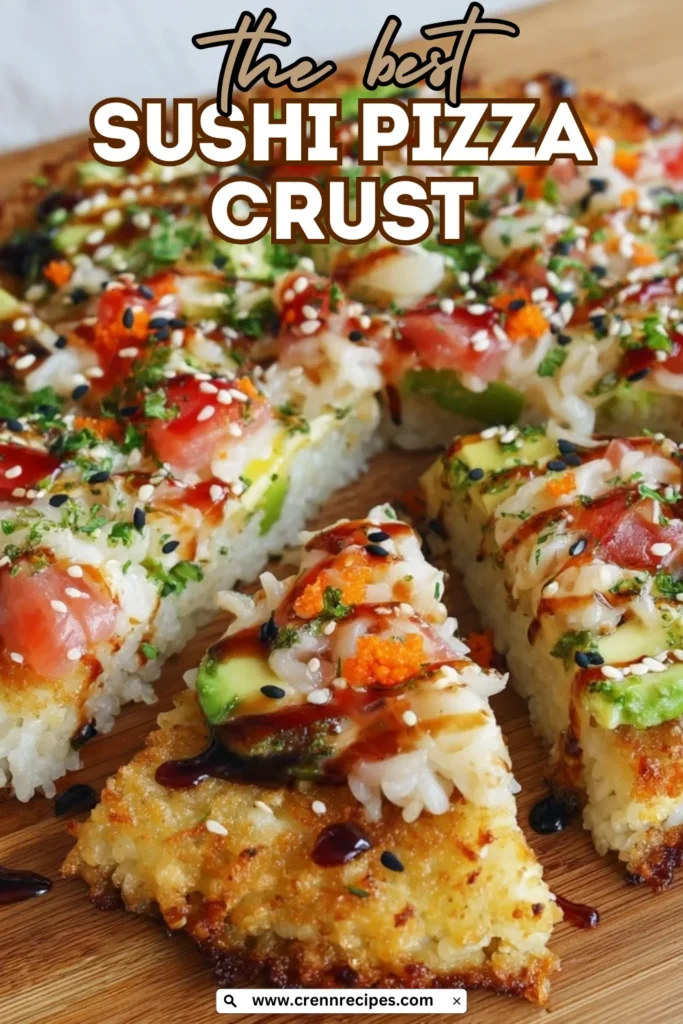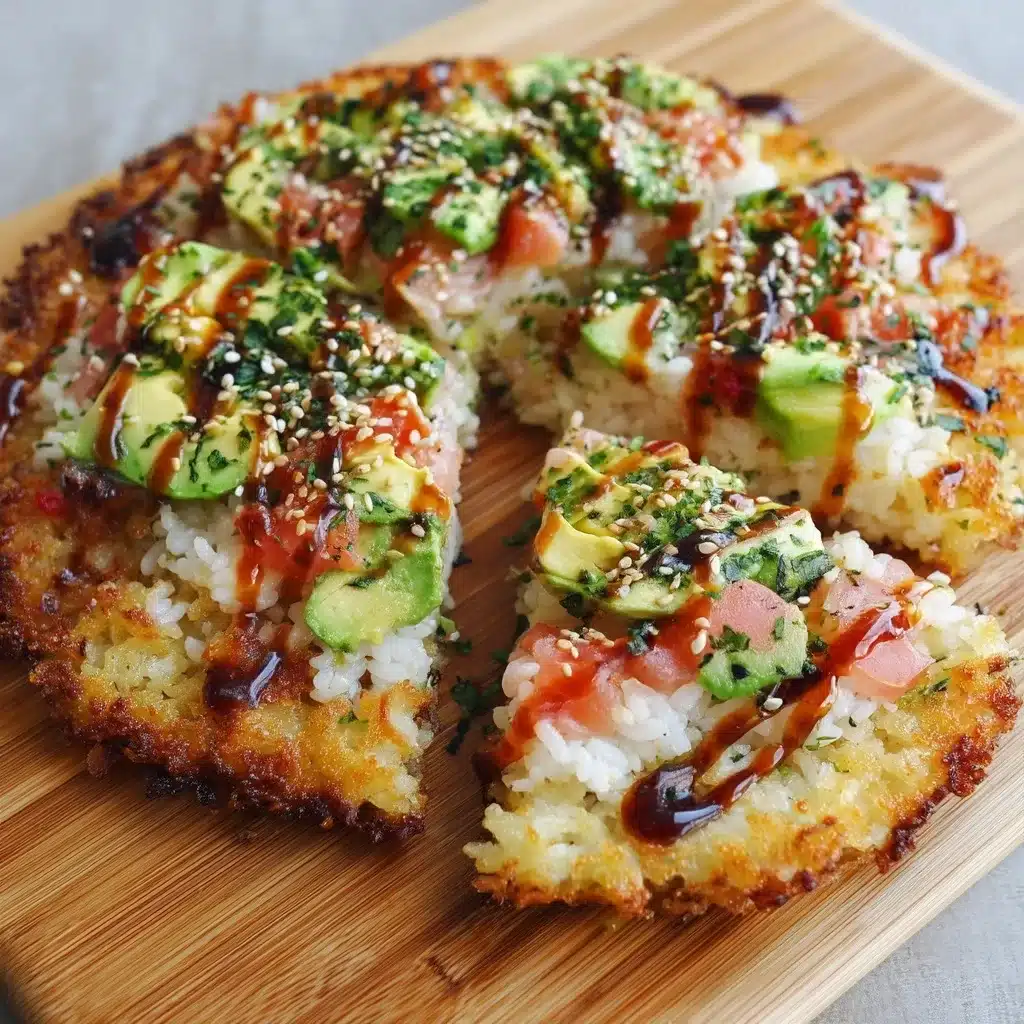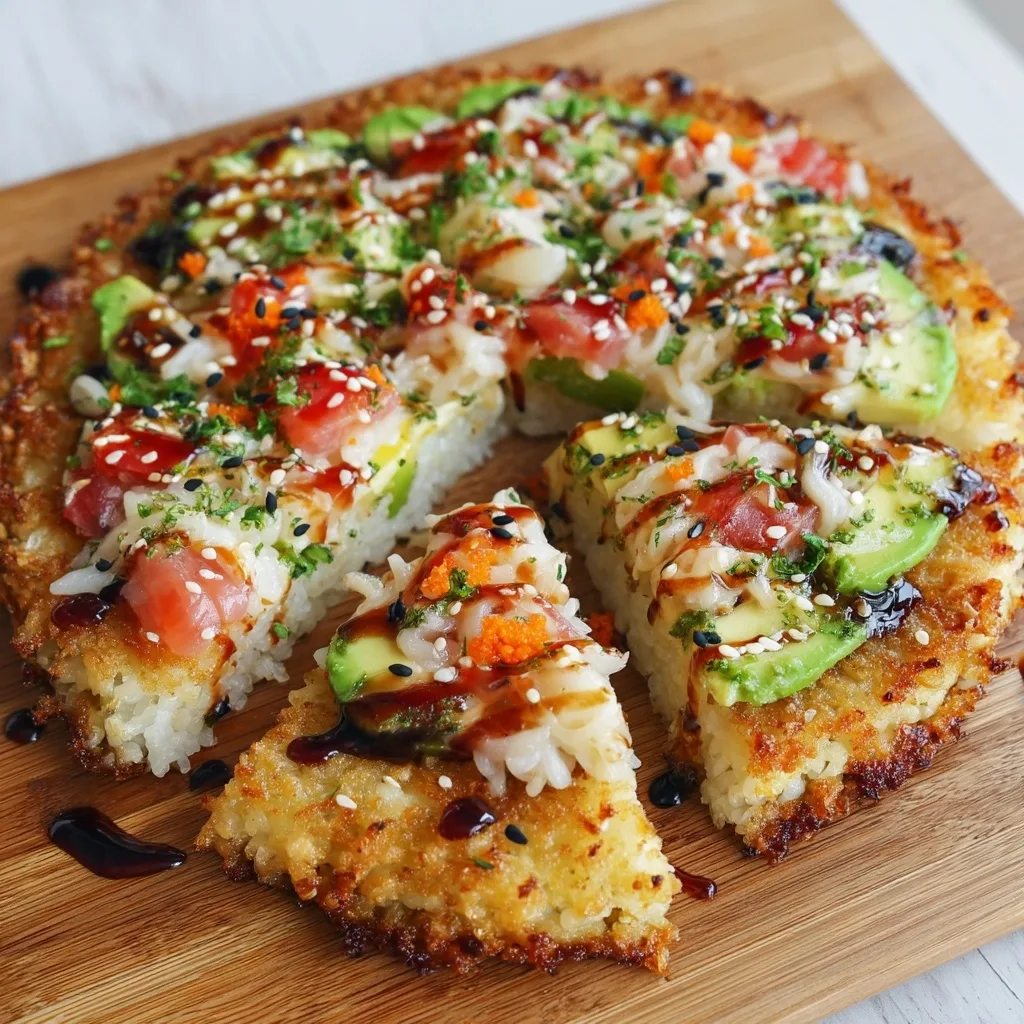When East meets West in the kitchen, magic happens. That’s exactly what you’ll experience with this incredible Sushi Pizza Crust recipe that’s been taking American kitchens by storm. This innovative fusion dish combines the beloved flavors of traditional Japanese sushi with the familiar format of pizza, creating something that’s both comfortingly familiar and excitingly new.
The genius of this Sushi Pizza Crust lies in its simplicity and versatility. Rather than struggling with traditional pizza dough that requires rising time and precise techniques, this recipe transforms perfectly seasoned sushi rice into a crispy, golden foundation that’s ready to support whatever creative toppings your heart desires. Whether you’re a sushi novice looking for an approachable entry point into Japanese flavors or a seasoned chef seeking to impress dinner guests with something unexpected, this American Chef Style approach delivers every time.
What makes this recipe particularly special is how it bridges cultural gaps through food. The technique respects traditional sushi rice preparation while adapting it for a completely different application. The result? A dish that feels both exotic and accessible, perfect for family dinners, party appetizers, or when you’re craving something that breaks the mold of ordinary weeknight meals.
The Fusion Revolution: Understanding Sushi Pizza Origins
The concept of Sushi Pizza Crust represents more than just a trendy recipe—it’s part of a broader culinary movement that’s been gaining momentum across American kitchens. This fusion approach originated from the creative minds of chefs who recognized that great flavors transcend traditional boundaries. By taking the foundational elements of sushi—perfectly seasoned rice, fresh ingredients, and umami-rich seasonings—and presenting them in a pizza format, this dish appeals to adventurous eaters while remaining approachable for those hesitant about raw fish.
The beauty of this American Chef Style interpretation lies in its flexibility. Unlike traditional sushi that requires specific techniques and expensive ingredients, this Sushi Pizza Crust can be customized to suit any taste preference or dietary restriction. You can load it with traditional sushi ingredients like salmon and avocado, or go completely non-traditional with cooked proteins and Western vegetables. The rice crust serves as a neutral canvas that enhances rather than competes with your chosen toppings.
From a nutritional standpoint, this Sushi Pizza Crust offers several advantages over traditional wheat-based pizza crusts. Rice provides easily digestible carbohydrates and is naturally gluten-free, making it suitable for those with celiac disease or gluten sensitivities. The addition of sesame oil contributes healthy fats and that distinctive nutty flavor that’s essential to authentic Asian cuisine. When topped with fresh vegetables, lean proteins, and minimal processed ingredients, this becomes a relatively healthy meal option that doesn’t sacrifice flavor for nutrition.
Mastering the Art of Sushi Rice for Pizza
The foundation of any exceptional Sushi Pizza Crust begins with properly prepared rice. Not all rice varieties will work for this application—you need short-grain sushi rice that has the natural stickiness required to hold the crust together. The starches in sushi rice create natural binding properties that, when combined with the egg and oil in this recipe, form a cohesive crust that can be sliced and served without falling apart.
Temperature control is crucial when preparing your rice base. Starting with warm, freshly cooked rice allows the seasonings to be absorbed more effectively, but the rice shouldn’t be so hot that it cooks the beaten egg when mixed together. The ideal temperature is when the rice has cooled enough to handle comfortably but still retains some warmth. This sweet spot ensures that the rice vinegar mixture penetrates evenly throughout each grain while the egg remains in its liquid state to act as a proper binding agent.
The seasoning mixture of rice vinegar, sugar, and salt mirrors traditional sushi rice preparation, but the proportions have been adjusted specifically for this Sushi Pizza Crust application. The slightly increased sugar content helps with caramelization during the frying process, creating that beautiful golden color and subtle sweetness that complements both traditional and non-traditional toppings. The salt enhances all the other flavors while the rice vinegar provides the characteristic tang that makes sushi rice so distinctive and addictive.

Essential Ingredients and Their Roles
The Rice Foundation
Short-grain sushi rice forms the backbone of this recipe, and there’s really no suitable substitute. The high starch content and natural stickiness of sushi rice are what allow the crust to hold together during cooking and slicing. When shopping for rice, look for varieties specifically labeled as “sushi rice” or “short-grain rice.” Brands like Nishiki or Kokuho Rose are widely available and produce excellent results for this Sushi Pizza Crust.
The cooking method for your rice matters significantly. Properly cooked sushi rice should be tender but still have a slight bite—never mushy or overcooked. Each grain should be distinct while still clinging to its neighbors. If you’re using a rice cooker, follow the manufacturer’s instructions for sushi rice. If cooking stovetop, use a 1:1.1 ratio of rice to water, bring to a boil, then reduce heat and simmer covered for 18 minutes before resting off heat for 10 minutes.
The Binding Elements
The beaten egg serves as more than just a binder in this Sushi Pizza Crust—it also contributes to the golden color and helps create that satisfying crispy texture we’re after. Use room temperature eggs for best incorporation, and beat them thoroughly before adding to ensure even distribution throughout the rice mixture. Some cooks prefer to use just the egg white for a lighter texture, but the whole egg provides richer flavor and better binding properties.
Sesame oil brings an essential nutty depth that’s characteristic of Asian cuisine. A little goes a long way—too much can overpower the delicate rice flavors and make the crust overly greasy. The oil also contributes to the crisping process, helping create that perfect contrast between the crispy exterior and tender interior that makes this Sushi Pizza Crust so appealing.
Seasoning Components
Rice vinegar is crucial for authentic flavor development. Its mild acidity brightens the overall taste while the sugar balances that acidity with subtle sweetness. Together with salt, these three ingredients create the classic sushi rice seasoning that transforms plain rice into something special. The optional soy sauce adds umami depth and a slightly darker color, but it’s not essential if you prefer a milder flavor profile or are serving guests who might be sensitive to sodium.
Step-by-Step Technique Mastery
Preparing the Perfect Rice Base
Begin by allowing your cooked sushi rice to cool to a comfortable handling temperature—warm but not hot. In a small bowl, whisk together the rice vinegar, sugar, and salt until the sugar completely dissolves. This seasoning mixture should be smooth and well-combined before adding to the rice. Pour this mixture over the rice and use a cutting and folding motion to incorporate it evenly. Avoid stirring aggressively, which can break the rice grains and create a mushy texture that won’t hold together well in your Sushi Pizza Crust.
Once the seasoning is evenly distributed, add the sesame oil, beaten egg, and optional soy sauce. Again, use gentle folding motions to combine these ingredients without breaking down the rice structure. The mixture should look cohesive and slightly glossy from the oil and egg. At this point, the rice should hold together when pressed but not feel overly wet or sticky.
Forming and Shaping Techniques
The key to a successful Sushi Pizza Crust lies in proper shaping and compacting. Use an 8-10 inch non-stick skillet for best results—this size creates a crust that’s substantial enough to support toppings while remaining manageable for flipping. Line your skillet with parchment paper or brush it generously with oil to prevent sticking.
Transfer your rice mixture to the prepared skillet and use clean hands or the back of a spoon to press it into an even layer. The goal is to create a compact, uniform thickness throughout—aim for about ½ inch thick. Pay special attention to the edges, ensuring they’re well-packed and even with the center. A well-formed base is crucial for achieving that perfect crispy texture that defines a great Sushi Pizza Crust.
The Critical Cooking Process
Heat your cooking oil over medium heat—this temperature is crucial for achieving the perfect texture. Too high and the outside will burn before the inside sets; too low and you won’t get that essential crispy crust. The oil should shimmer but not smoke when ready. Carefully transfer your formed rice base to the hot skillet, listening for that satisfying sizzle that indicates proper temperature.
Cook the first side for 7-10 minutes without moving or disturbing the crust. You’ll know it’s ready to flip when the edges start to look golden and the bottom feels firm when gently lifted with a spatula. The flipping process requires confidence and the right technique—use a large plate to invert the crust, then slide it back into the skillet uncooked-side down. Cook the second side for 5-7 minutes until equally golden and crispy.

Creative Topping Combinations and Serving Ideas
Traditional Japanese-Inspired Toppings
For purists who want to honor the sushi tradition, start with classic combinations that showcase the Sushi Pizza Crust without overwhelming it. Thinly sliced avocado arranged in overlapping patterns creates both visual appeal and creamy texture contrast. Fresh cucumber adds crisp freshness and helps balance richer toppings. High-quality smoked salmon provides that traditional sushi experience while eliminating concerns about raw fish preparation.
Spicy tuna made with canned tuna, mayonnaise, and sriracha offers another traditional option that’s both accessible and delicious. The key is using high-quality canned tuna and adjusting the spice level to your preference. This topping works particularly well on the Sushi Pizza Crust because the rice base can support the moisture content without becoming soggy.
Fusion and Creative Options
The beauty of this Sushi Pizza Crust lies in its versatility for non-traditional toppings. Cooked shrimp with a tangy cocktail sauce creates an American-Asian fusion that appeals to seafood lovers. Grilled chicken teriyaki provides a heartier option that transforms this from appetizer to main course. Even vegetarian options like marinated tofu, roasted vegetables, or fresh sprouts work beautifully.
For those who enjoy heat, consider combinations like spicy mayo drizzled over cucumber and radish slices, or a Korean-inspired version with kimchi and sesame seeds. The neutral rice base of the Sushi Pizza Crust provides the perfect foundation for experimenting with bold flavors and unexpected combinations.
Sauce and Garnish Techniques
The finishing touches can elevate your Sushi Pizza Crust from good to extraordinary. Spicy mayo—a mixture of mayonnaise and sriracha—should be drizzled artistically rather than spread heavily. Eel sauce adds sweet umami depth and glossy visual appeal. These sauces should complement rather than mask the fresh flavors of your toppings.
Garnishes like thinly sliced green onions, toasted sesame seeds, or even crushed seaweed chips add textural interest and authentic flavor notes. Fresh herbs like cilantro or shiso (if available) provide aromatic freshness that brightens the entire dish. The key is restraint—each element should serve a purpose rather than simply adding complexity for its own sake.
Pro Tips for Sushi Pizza Crust Success
Timing and Temperature Control
Success with this Sushi Pizza Crust often comes down to proper timing and temperature management. The rice should be seasoned while still warm but cooled enough that the egg doesn’t cook when mixed in. If your rice has cooled too much, you can gently warm it in the microwave for 30-second intervals, stirring between each warming.
During the cooking process, resist the urge to check the bottom too frequently. Each time you lift the crust, you release heat and steam that’s crucial for proper cooking. Trust the timing and listen for changes in the sizzling sound—it should remain fairly consistent throughout the cooking process.
Equipment Recommendations
A good non-stick skillet is essential for this recipe. Cast iron can work but requires more oil and careful temperature control to prevent sticking. The non-stick surface allows for easier flipping and cleaner release of the finished Sushi Pizza Crust. If you don’t have a non-stick skillet, use extra oil and consider using parchment paper as a liner.
A wide, thin spatula is invaluable for the flipping process. Some cooks prefer the plate method for flipping, but a large spatula can work if you’re confident in your technique. The key is having tools that allow you to flip the crust in one smooth motion without breaking it apart.
Storage and Reheating Guidelines
While this Sushi Pizza Crust is best served fresh, you can prepare the rice base ahead of time and store it covered in the refrigerator for up to 24 hours before cooking. If you need to reheat a cooked crust, use a low oven (250°F) for 5-10 minutes rather than the microwave, which can make the crust soggy.
Leftover topped Sushi Pizza Crust should be consumed within a day for best quality, especially if topped with fresh fish or vegetables. The rice base holds up well, but fresh toppings can deteriorate quickly. When storing, place in an airtight container and refrigerate promptly.
Nutritional Benefits and Dietary Considerations
This Sushi Pizza Crust offers several nutritional advantages over traditional wheat-based pizza crusts. Rice provides easily digestible carbohydrates and is naturally gluten-free, making it suitable for those with celiac disease or gluten sensitivities. The portion size is typically smaller than traditional pizza, which can help with portion control while still providing satisfaction.
The eggs in the recipe contribute high-quality protein and essential amino acids. Sesame oil provides healthy monounsaturated fats and has been linked to various health benefits in traditional medicine. When topped with fresh vegetables and lean proteins, this becomes a well-balanced meal that provides sustained energy without the heavy feeling often associated with traditional pizza.
For those watching sodium intake, the soy sauce can be omitted or replaced with a low-sodium alternative. The rice vinegar provides flavor enhancement without adding significant sodium. This makes the Sushi Pizza Crust adaptable for various dietary restrictions while maintaining its delicious flavor profile.

Troubleshooting Common Issues
Crust Falls Apart During Cooking
If your Sushi Pizza Crust breaks apart during cooking, the most likely cause is insufficient binding or improper rice preparation. Ensure you’re using short-grain sushi rice and that it’s been properly seasoned while still warm. The egg should be well-beaten and evenly distributed throughout the rice mixture. Pressing the rice firmly into the skillet before cooking is crucial for creating a cohesive crust.
Uneven Browning or Burning
Temperature control is critical for even browning. If one area is browning too quickly, your heat may be too high or unevenly distributed. Reduce the heat slightly and ensure your skillet is the right size for your burner. Some skillets have hot spots that can cause uneven cooking—rotating the skillet occasionally can help compensate for this.
Soggy or Mushy Texture
A soggy Sushi Pizza Crust usually results from overcooking the rice initially or not allowing enough moisture to evaporate during the crisping process. Ensure your rice is cooked to the proper texture before seasoning, and don’t rush the crisping process. Each side needs adequate time to develop that golden, crispy exterior that provides textural contrast to the tender interior.
Hosting and Presentation Ideas
This Sushi Pizza Crust makes an excellent centerpiece for casual dinner parties or creative date nights. Consider making multiple smaller crusts with different topping combinations to create a tasting experience. Cut each crust into wedges and arrange on a large platter with small bowls of various sauces for dipping and drizzling.
For a more interactive experience, prepare the crusts ahead of time and set up a topping station where guests can customize their own portions. Provide an array of fresh vegetables, proteins, sauces, and garnishes, allowing everyone to create their perfect combination. This approach works particularly well for mixed groups where some guests might prefer traditional flavors while others want to experiment.
The visual appeal of a well-topped Sushi Pizza Crust makes it highly photogenic for social media sharing. The contrast between the golden rice crust and colorful fresh toppings creates an Instagram-worthy presentation that’s sure to impress friends and followers alike.
Seasonal Variations and Special Occasions
Adapt your Sushi Pizza Crust to seasonal ingredients for year-round enjoyment. Spring versions might feature fresh peas, radishes, and herbs. Summer calls for cucumber, tomatoes, and fresh herbs. Fall adaptations could incorporate roasted squash or sweet potato elements, while winter versions might focus on heartier proteins and preserved vegetables.
For special occasions, consider themed variations. A Valentine’s Day version could feature heart-shaped cutouts and pink-hued ingredients like pickled radishes. Holiday versions might incorporate red and green vegetables or special garnishes that reflect the celebration.
The versatility of this Sushi Pizza Crust makes it suitable for everything from casual family dinners to elegant cocktail parties. The key is matching your toppings and presentation style to the occasion while maintaining the fundamental techniques that make this dish successful.
More Related Recipes You Might Enjoy
- Holiday Mocktail – Perfect refreshing beverage to pair with this Asian-fusion dish
- Herb Chicken Bowls – Another creative bowl-style dish that shares the customizable, fresh approach
- Pumpkin Muffins – A delightful sweet treat that showcases fusion cooking techniques with unexpected ingredients
This Sushi Pizza Crust represents the best of fusion cooking—taking beloved elements from different culinary traditions and combining them into something new and exciting. Whether you’re looking to expand your cooking repertoire, impress dinner guests, or simply try something different, this recipe delivers on all fronts while remaining approachable for home cooks of all skill levels.
Print
Sushi Pizza Crust: Ultimate Fusion Recipe Guide
- Total Time: 30 minutes
- Yield: 4–6 servings 1x
- Diet: Gluten Free
Description
A crispy, golden sushi pizza crust made from seasoned sushi rice that’s pan-fried to perfection. This fusion dish combines Japanese flavors with pizza format for an incredible appetizer or main course.
Ingredients
- 2 cups sushi rice (cooked and cooled)
- 2 tablespoons rice vinegar
- 1 tablespoon sugar
- ½ teaspoon salt
- 1 tablespoon sesame oil (plus extra for frying)
- 1 egg, beaten
- 1 tablespoon soy sauce (optional)
- Neutral oil for frying (avocado or vegetable oil)
Instructions
- Mix rice vinegar, sugar, and salt in a small bowl until dissolved. Pour over warm cooked rice and fold gently.
- Stir in sesame oil, beaten egg, and soy sauce (if using) until well combined.
- Press rice mixture into an 8-10 inch non-stick skillet lined with parchment or oiled.
- Heat oil over medium heat. Cook rice crust 7-10 minutes until golden underneath.
- Flip carefully using plate method and cook 5-7 minutes more until crispy.
- Let cool 5 minutes before adding toppings.
Notes
- Use short-grain sushi rice for best binding
- Don’t overcook the rice initially – it should be tender but firm
- Press rice firmly into pan for cohesive crust
- Cool slightly before topping to prevent soggy toppings
- Prep Time: 15 minutes
- Cook Time: 15 minutes
- Category: Appetizer, Main Course
- Method: Pan-frying
- Cuisine: Asian Fusion
Nutrition
- Serving Size: 1 slice (1/6 of crust)
- Calories: 185
- Sugar: 3g
- Sodium: 290mg
- Fat: 4g
- Saturated Fat: 1g
- Unsaturated Fat: 3g
- Trans Fat: 0g
- Carbohydrates: 34g
- Fiber: 1g
- Protein: 4g
- Cholesterol: 31mg

